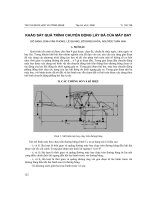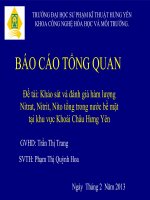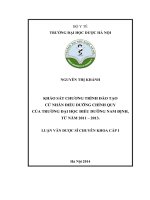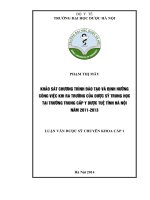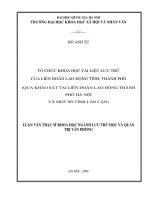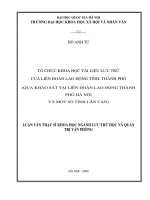Khảo sát quá trình lan truyền xung cực ngắn trong sợi quang tinh thể tt tiếng anh
Bạn đang xem bản rút gọn của tài liệu. Xem và tải ngay bản đầy đủ của tài liệu tại đây (1.92 MB, 26 trang )
MINISTRY OF EDUCATION & TRAINING
VINH UNIVERSITY
_______________________
Do Thanh Thuy
INVESTIGATION OF ULTRASHORT PULSE
PROPAGATION IN PHOTONIC CRYSTAL FIBERS
Specialization: Optics
Code: 9 44 01 10
ABSTRACT OF DOCTORAL THESIS IN PHYSICS
Vinh - 2020
0
The work is achieved in
VINH UNIVERSITY
Adviser:
1. Prof. Dr. Dinh Xuan Khoa
2. Dr. Bui Dinh Thuan
Reviewer 1: Prof. Dr. Tran Cong Phong
Reviewer 2: Prof. Dr Nguyen Huy Cong
Reviewer 3: Prof. Dr Luu Tien Hung
The thesis was defensed before the doctoral admission board of
Vinh university at …h…, ….……., …, 2020
The thesis can be found at:
- Nguyen Thuc Hao library of Vinh university
- Viet Nam National library
1
PREFACE
Reason to choice the investigation subject
Because of its applications in many fields of science, technology
and life, the propagation of the optical soliton in the optical fiber has
been being an interesting and attracting subject of scientifics.
Normally, the soliton’s propagation is stable when its power is high
enough so that the Kerr effect is balanced by the group velocity
dispersion in medium. Depending on pulse power and specific
parameters of medium, the soliton can have own different orders.
However, the first-order soliton, i.e., the fundamental soliton can
only keep its shape and spectrum, meanwhile the shape and spectrum
of the higher-order soliton always periodically change. For the
ultrashort pulse, the high-order dispersion and nonlinear effects give
rising of soliton’s disturbance. Since that the frequency shift due to
the Raman induced scattering and dispersion waves appear.
Corresponding to the soliton disturbance, there is the soliton fission
which is the main reason of supercontinuum (SC) generation. The SC
generation appears when the powerful pulse propagates through the
high nonlinear medium, in which the nonlinear effects as: soliton
fission, Raman induced scattering, high-order group velocity
dispersion, four-wave mixing rise up together.
Lately, the optical group in Vinh university has paied attention on
the SC generation in the photonic crystal fibers (PCF). The obtained
results lead to generate SC in the infrared region.
Moreover, last years, the theoretical and experimental works in
the SC generation have focused on the influence of configurations,
ground and infiltrated materials on the SC generation efficiency and
its spectrum. The explicit analysis of nonlinear processes and their
influence of one on other are not cared enough about.
In the face of above mentioned questions, we choice investigation
subject with title “Investigation of ultrashort pulse in photonic
crystal fibers” .
The purpose
2
- Investigation of the influence of high-order dispersive
nonlinear effects on the pulse separation and spectral broadening of
ultrashort pulse propagating in photonic crystal fiber.
- Propose the optimal model of PCF PBG08-ethanol for SC
generation at 1560 nm.
- Investigation the influence of pulse parameters on the SC
generation.
- Design and set-up experiment system using available PCF
to observe the SC spectrum and to verify the influence of some
parameters on power and spectrum.
The contents
- Derive the equation describing the propagation of
ultrashort pulse in PCF. Use it to simulate the influence of high-order
dispersive and nonlinear effects spectral broadening.
- Propose modelPCF and investigate the influence of some
parameters on the dispersion, zero-dispersion wavelength, and
nonlinear coefficient. Since that to find optimal values for SC
generation at 1560 nm.
- Simulate SC generation and investigation the influence of
pump pulse parameters on SC generation in proposed PCF.
- Design and set-up experiment system using available PCF
to observe the SC spectrum and to verify the influence of some
parameters on power and bandwidth.
The methods
Theoretical simulation combining with experiment.
The original contributions
i)
Has proposed the model of PCF PBG 08 - ethanol with
optimal parameters use to generate SC.
ii)
Has simulated the nonlinear processes which play the
main role in supercontinuum generation and found out the
influence of
PCF configuration and laser pulse
parameters on supercontinuum spectrum.
iii)
Has designed the experimental system to generate SC in
3
available PCF.
Chapter 1. OPTICAL AND PHOTONIC CRYSTAL FIBERS
In this chapter, the development, configuration, classification,
main optical properties of photonic crystal fibers used for ultrashort
pulse transmission and SC generation are summaried
Chapter 2. PROPAGATION OF LASER PULSE
IN NONLINEAR FIBER
2.1 . Progagation equation in optical fiber
2.1.1. Maxwell equations
The propagation of electromagnetic field in optical medium is
described by Maxwell equations. From which, the wave equation and
nonlinear Schrodinger equation are derived to describe the
propagation of short and ultrashort pulse in nonlinear medium,
generally, and fiber, especially.
2.1.2. Propagation of short pulse
Using slow-variable envelope approximation, the Schrodinger
nonlinear equation decribing the propagation of short pulse is derived
as following:
2 3 (3)
2
i A z, t i 1 A z, t 2 2 A z, t 0 2
A z, t 2 A z, t 0
(2.14)
z
t
2 t
2c 4
where 3 (3) 0 / 8n 0 c n20 / c is
nonlinear
coefficient
(3)
corresponding to third-order nonlinearty, n2 3 8 n 0 is the
nonlinear coefficinet of refractive index.
2.1.3. Propagation of ultrashort pulse
The micro process has own specific time of (0.110) fs,
meanwhile, the ultrashort pulse has its duration from 10 fs to
hundreds fs, so it is not accurately to assume that the optical response
of medium is instantaneous. Thus, in the expression of the nonlinear
polarization of medium must be the terms of response delay. We
have Schrodinger nonlinear equation for ultrashort pulse as
4
following:
i
A z, t
z
i 1
A z, t 2 2 A z, t i
3 A z , t 3 02 (3)
3
2
t
2 t
6
t 3
8 c2
t
1 n '
2
1 i 1 f R A z, t A z, t f R A z, t hR t t1 A z , t1 2 dt1 0.
0 n t
(2.20)
Using normalized arguments and function as following:
U ,
t 1 z
0
1
P0
A z , t , LD
,
02
L
1
, LN
, N2 D ,
2
P0
LN
3
z
, 3
,
LD
6 2 0
(2.27)
T
S s , R R .
0
0
We have:
U
U
i 2U
3U
sign 2
i N 2 U 2U i S
U 2U R U
3
2
3
2
2
(2.28)
2.2. Numerical simulation methods
Using methods as split-step Fourier or four-order Runge-Kutta to
solve Eq.(2.28) with different limit conditions.
2.3. Influence of dispersion and nonlinear effects on propagation
of pulse in optical fiber
2.3.1. Influence of high-order dispersion
To simply, first we consider third-order dispersion, and assume
that the Raman induced scattering and pulse shock are ignorable. For
this case Eq. 2.28 is simplified to:
(2.48)
If the centrum wavelength of pulse is close to the zero-dispersion
one, the third-order dispersion play the main role, i.e. 2=0 and 30.
For this case Eq. (2.48) will be modified with normalized paramters:
,
,N =
and given as following:
U
1 3
sign( 3 )
iN | U |2 U
6 3
(2.49)
Considering β3 = 0.1 ps3/km, the propagation of pulse is simulated
5
and illustrated in Fig.2.1.
Fig. 2.1
Propagation
of
hyperbolic secant with
β3=0.1
ps3/km
through
normalized
distance of = 12
From Fig.2.1 we can see the input intensity will be separated to
some small pulses in certain delay time. It results the begin spectrum
will separated to two parts which is blue and red shifted
Next, we consider the second-order dispersion plays the main role
and the third-oder one is seem as disturbance. It means = 0.02,
S = 0 and = 0, and substituting into Eq. (2.28) we have:
U
i 2U
3U
sign 2
i N 2 U 2U
3
2 2
3
(2.50)
The propagation of soliton of N = 3 is presented in Fig. 2.2.
From this figure we can see a fundamental soliton will be separated
at normalized distane of = 0.38. That means the dispersion wave
is blue shifted.
Fig. 2.2 (a) Pulse shaping; (b) Spectral changing.
6
Simulated for N = 3, z = 1.2LD ,
= 0.02, S = 0 and
=0
As we known, dispersion coefficient can have possitive or minus
sign. So in Fig.2.3 the propagation of pulse in anomous-dispersion
medium with <0. The values of other paramters are similar to that
used in Fig.2.2. In this case there is a spectral peak in low-frequency
region 0 (red shift) as shown in Fig.2.3b. Thus, in this case, a
portion of pulse energy is separated from centrum region as
dispersion wave which propagates more speedly then input pulse. It
results the input pulse broadens.
Fig. 2.3. (a) Pulse shaping , (b) Spectral change.
Simulated for N = 3 , z = 1.2LD , = - 0.02, S = 0 and
=0
Fig.2.4 is results simulated for the case of N = 3.2, z = 2LD ,
= 0.02, = 0,0005. If we consider to the fourth-order dispersion.
From Fig.2.4 we can see that if consider to disturbance by the fourthorder dispersion and odd soliton, the balance between the secondorder dispersion and self-phase modulation appears not,
consequenlty, the output shape and spectrum of pulse becomes more
complex.
Fig.2.4. (a) Pulse shaping , (b) Spectrum change.
7
Simulated for N = 3.2 , z = 2LD ,
= 0.02, and
= 0.0005
2.3.2. Influence of Raman induced scattering
The Raman-induced frequency shift (RIFS) is the fact to make
spectrum red shifts (Fig.2.5). The magnitude of RIFS is proportional
to T04 , where T0 is the duration of input pulse which is very large
for ultrashort pulse. If ultrashort pulse with T0 = 50 fs propagates in
fiber, the RIFS is priority in comparison to dispersion, consequently,
Eq. (2.28) can be simplified as:
(
)
(2.51)
Fig.2.6 presents the propagation of ultrashort hyperbolic secant
pulse with power of N = 3 (equivalent to 3 fundamental solitons)
through normalized distance of =0.8. We can see that with
increasing of the intensity, the frequency changes not only, but the
soliton fission appears too (Fig. 2.6b).
8
Fig. 2.5. Raman-induced frequency shift for soliton N=1
Fig. 2.6. Raman-induced frequency shift for soliton N = 3
2.3.3. Influence of pulse self-steepening
To clearly understant the nature of the pulse self-steepening, we
assume other nonlinear effect are ignorable. Let 2 = 0, 3 = 0, the
Eq.(2.28) is modified as:
iN2 (
(
9
))
(2.52)
Fig. 2.7. Ultrashort pulse self- steepning through different normalized
distance
Fig. 2.7 is pulse self-steepening simulated for the case of = 0, =
0.6; = 1.2 với S = 0.03 and N = 1. From this figure we can see that
after propagating through a distance of fiber, the ultrashort pulse will
be unsymetrically reshaped. Its trailing edge is steepened up.
Continuously, we investigate the influence of the second-oder
dispersion on the pulse self-steepening. The results in Fig. 2.8 are
simulated for case of S = 0.03, N = 1 , = 0, 25 and 50. This figure
shows that group velocity disprersion (GVD) can vanishing the
optical shock, and then smooth trailing edge. In Fig.2.9 are results
simulated for the case of S = 0.03 and N=2. We see that if N = 2,
there is the overlap of two pulses.
Fig. 2.8. Propagation of hyperbolic pulse with N=1
10
Fig.2.9. Propagation of hyperbol with N = 2
2. 4 Conclusion
1. The high-order dispersion effects cause the perturbane process,
and then results the phase mismatch and dispertion wave generation.
The generated pulse propagates with different velocity, consequently,
the spectrum broadens.
2. The Raman induced frequency shift is the main reason of red shift
of pulse spectrum. If pulse with power high enough the soliton
fission appears in the nonlinear fiber.
3. The pulse self-steepening can appear depending on the pulse
intensity. It results the optical shock in trailing edge.
The mentioned effects investigated above will play the main role in
the SC generation in PCF which will be presented in the next chapter.
Chapter 3. INVESTIGATION OF ULTRASHORT PULSE
PROPAGATION IN PHOTONIC CRYSTAL FIBER
3.1. Supercontinuum generation and investigation model
3.1.1. Supercontinuum generation in PCF
The SC generation can be illustrated by the evolution presented
in Fig.3.1.
11
Fig. 3.1. Evolution scheme of supercontinuum generation in PCF
3.1.2. Propose model PCF PBG 08 - ethanol
The model of PCF proposed is presented in Fig.3.2.
The PCF PBG 08 is drawed from glass PBG 08 of chemical
components as: 40% SiO2, 30% PbO, 10% Bi203, 13%Ga203,
7%CdO, 0,6% Sb2O3 and hexagonal lattice with seven rings of
capillaries (holes). The parameters d, d’, are the diameter of first
ring, hole and pitch, respectively. The holes are infiltrated by ethanol.
Next, we investigate the influence of d on the dispersion
characteristics, as well as nonlinearity of PCF PBG08-ethanol. Let d
changes from 0.8 μm to 2.8 μm, and d’ 2 μm, = 3 μm. We
simulate to find the optimal configuration for SC generation at
wavelength of 1.560 m.
12
Fig. 3.2. (a) Cross-section
of proposed PCF
(b) Transverse intensity
distribution of fundamental mode at
1.56 m
Using expression describing dispersion, refractive indeces of glass
PBG 08 and ethanol, the dispersion characteristics, shift of zerodispersion wavelength, effective area of fundamental mode, and
nonlinear coefficient of PCF PBG 08 - ethanol are simulated and
presented in the next sections.
3.2. Dispersion and nonlinearity of PCF PBG 08 - ethanol
In Fig. 3.3 there are dispersion characteristics of PCF PBG 08 ethanol with d d’ 2 µm which is infiltrated by ethanol (red curve)
and by air (blue).
Fig. 3. 3.
Dispersion
characteristics
of
PCF PBG 08 ethanol red) and PCF
PBG 08 - air (blue)
with d =d’=2 µm
We can see the zero-dispersion wavelength of PCF PBG08ethanol is shifted ZDW 45 nm from that of PCF PBG 08 - air.
13
Fig. 3.4. (a) Dispersion characteristics of PCF PBG 08 - ethanol with
different values of d;(b) The ZDW vs. d
From Fig.3.4 we can see that if d increases ZDW is red shifted.
The PCF PBG 08 - ethanol with d changing from 1.7856 µm to
1.4716 µm has ZDW shifting from 1.8413µm to 1.5069 µm. With
changing of d, ZDW will be 55.7 nm (maximum) for d = 0.8 µm and
35.3 nm ( minimum) for d = 2.8 µm (Fig.3.4b).
To investigate the SC generation of pulse at wavelength 1.560 m,
we have to simulate the effective area of fundamental mode Aeff and
nonlinear coefficient of t PCF PBG 08 - ethanol with different d
( Fig. 3.5).
Fig 3.5.
Dependence
of
Aeff and on d at
wavelength of 1,560
m
The results form Fig 3.5 show that the effective area of fundamental
mode Aeff is investly proportional to d and in opposition, the
nonlinear coefficient is proprtional to d. It is clear that if d
increases from 0.8 upto 2.8m, Aeff decreases from 16.7933µm2
downto 4.90844 µm2, meanwhile increases from 0.1031W-1m-1 upto
0.3528 W-1m-1.
14
3.3. Influence of principle parameters on SC generation in PCF
PBG 08 - ethanol
3.3.1 High-order dispersion
The fission process of soliton in PCF is described by following
equation:
i m 1 m
A z, t A z, t m
A z, t
z
2
m ! t m
m 2
2
i
i 1
A z, t R t ' A z, t t ' dt '
t
0
(3.5)
The simulation has been done for the hyperbolic secant
t
A z 0, t P0 sech
T0
Where T0 is duration, P0 is the peak power at centrum wavelength of
1.560 m.
Fig 3.6 illustrates the influence of the high-order dispersion on SC
spestrum generated at distance of z = 10 cm with input pulse with P0
=12 kW and T0 = 28.4 fs. In the case if the third-order dispersion is
concerned only, the SC spectrum will broaden from 1000 nm to 3250
nm. However, if the higher-order dispersions are concerned, the SC
spectrum will be narrowed. Here there is a blue shift, meanwhile the
long wavelength region is not changed. Moreover, the narrowing of
SC spectrum will be appeared more slowly for dispersion of higherorder. If nineth- or tenth-order dispersions are concerned, the SC
spectrum narrowing is ignorable. In Fig 3.7 there are dispersion
characteristics obtained by the Taylor fitting method, where the black
curve is obtained by the FE mode-solve method. If the third- or fourthorder dispersion is concerned only, the curves are splitted one from
other but if dispersions are concerned with its order upto tenth the
dispersion fitted curve coincides to D(). Using the fitted curve to Eq.
(3.5) we have accurate results.
15
Fig. 3.6.
SC spectrum at
z=10cm concerning
dispersion
with
different order
Fig. 3.7.
Dispersion
curves obtained by
FE method (black)
coinsides to that by
Taylor fitting upto
β10
The centrum wavelength of pulse is chosen of 1.56 m, means it lies
on the anomous - dispersion of PCF PBG 08 - ethanol with d = 2.6
μm. In this case, the SC generation will be affected by the soliton
fission, only. This process is illustrated in Fig3.8. The change of the
diameter d results the shiftting of zero-dispersion wavelength, at the
same time the effective area of fundamental mode and nonlinear
coefficient change too. As shown in Fig 3.9 the bandwidth of SC
spectrums are about of 1150 nm, 1600nm and 2000 nm for PCF
PBG08-ethanol with d = 1.2 m, 2.4 m and 2.6 m, respectively.
The narrowing of SC spectrum is caused by the deviation between
the centrum wavelength and zero-dispersion ones. This situation is
similar to that simulated the SC distribution along distance of PCF
PBG 08 - ethanol with different d ( Fig.3.10). However, the nonlinear
effects depends not only on nonlinear coefficient inside PCF PBG 08
- ethanol, but also on the power of input pulse. This comment will be
verified in the next section.
16
Fig. 3.8.
Change of shape
and SC spectrum
along
PCF
PBG08-ethanol
length
of
hyperbolic secant
pulse with power of
10kW
Fig. 3.9.
Influence of d on SC
spectrum
d = 1.2 m
ZDW = 1753 nm
d = 2.4 m
ZDW = 1600 nm
d = 2.6 m
ZDW = 1537 nm
Fig.3.10. Change of shape and SC spectrum along length of PCF PBG 08
- ethanol with different d of hyberbol secant pulse
17
3.3.2 Influence of input power
In this section, we investigate the influence of pulse power on the
SC generation. Consider the input pulse with 0 = 1.560 m, T0 =
28.4 fs and PCF PBG 08 - ethanol with d = 2.6 µm, Λ 3 µm and
ZDW = 1.537 m. For this choice, the SC generation will be in
anomous-dispersion regime. The results are in Fig. 3.11
(a)
(b)
(c)
Fig. 3.11. Change of shape and SC spectrum along length of PCF PBG08ethanol with different input powers: P0 = 3 kW (a), P0 = 6 kW (b) và P0 =
12 kW (c)
18
From Fig. 3.11 we can see that the soliton fission distance z is
invertly proportional to input power. It can be explained by that with
increasing of input power resulting the increasing of the nonlinearity
inside PCF PBG 08 - ethanol which is invertly proportional to interaction
length.
Fig. 3.12. SC spectrum at length of z =15cm
With different input powers: P0 =3 kW, 6 kW and 12kW.
In other side, from Fig.3.12 we also see that with increasing of
input power the bandwidth of SC spectrum inceases. The badwidth
of SC spectrum at z =15 cm is about of 1600 nm, 1250 nm and 800
nm corresponding to P0 =12 kW, 6 kW and 3 kW, respectively.
3.3.3. Influence of pulse duration
Now, we fix the input power of 12 kW, and change pulse duration
with three values of 50 fs, 200 fs and 400 fs. The simulated SC
spectrum is presented in Fig. 3.13. Here we pay attention only on
two cases of 200 fs and 400 fs to compare with the case of 50 fs
obtained above. For the case of 400 fs, the dynamical picture of
soliton is not more clear. Here we can point that for the case of 200
fs the SC broaddening is reduced at the beginning.
19
(
a)
Fig. 3.13. Sự thay đổi hình dạng và phổ của xung theo khoảng cách lan
truyền ứng với TFWHM=400 fs (a), 200 fs (b) và 50 fs (c)
Thus, the SC generation in PCF PBG 08 - ethanol will appear
when use a suitable input pulse. From obtained results we can
conclude that the SC generation will appear in PCF PBG 08 - ethanol
when use the input pulse with duration of 50 fs and power about of
kW and it centrum wavelength is close to the zero-despersion
wavelength.
20
3.4. Setting up experiment for SC Generation in PCF
3.4.1. Experiment scheme
Figure 3.14 presents the arrangement scheme and the experimental
set-up is in Fig. 3.15.
Fig.3.14.
Arrangement
scheme for SC
generation in
PCFs
Fig. 3. 15.
Picture of
experiment set-up at
Vinh university
The values of parameters are given: Laser pulse with pulse energy
of 8 nJ, peak power of 8 kW; average power of 600 mW, wavelength
of (760850) nm, repetition rate of 7590 Hz, bandwidth of 20 nm,
duration of (40120) fs; PCFfemtoWhite with: core diameter of 1.8
0.3 m; lattice pitch of 1.88 μm; hole diameter of 0.9 μm; zerodispersion wavelength of 1260 nm, length of 15 cm; and
spectroscope Yokogama model AQ6370D.
21
3.4.2. Influence of pump power on SC spectrum
Fig.19.
SC spectrum with
different pump power at
wavelength of 760 nm
and duration of 40fs
From Fig. 3.19 we can see that with increasing of pump power
the SC spectrum power as so as bandwidth increases, and more
smooth. This results are similar to that obtained in Fig 3.12.
3.4.3. Influece of wavelength on SC spectrum
Fixing power of 75 mW and duration of 40 fs and changing
wavelength, the SC spectrum with bandwidth of 600 nm is obtained
and presented in Fig. 3.20.
Fig.3.20.
PSC spectrum with
different wavelength.
We see that when the laser wavelength closes to zero-dispersion one,
the spectrum power increases.
3.5. Conclusion
Basing on the proposed model, the dispersion and nonlinear
properties of PCF PBG 08 - ethanol changes with changing of
diameter of the first capillary ring from 0.8 μm to 2.8 μm.
1) The zero-dispersion wavelength is shifted from 1.8413µm to
1.5069 µm, effective are of fundamental mode from 16.7933µm2 to
4.90844 µm2, and nonlinear ceofficient from 0.1031W-1m-1 to 0.3528 W22
m-1 when d changes from 0.8 μm to 2.8 μm.
2) The bandwidth of SC spectrum depends on the order of
dispersion, and the results will be accurate when the tenth-order
dispersion is concerned.
3) The SC generation in PCF PBG 08 - ethanol is
investigated with different values of parameters as: diameter of the
first ring, input power, duration at different length of fiber.
4) The experimental set-up is arranged using Titatium:
sapphire laser and PCF femtoWhile for SC generation. The power
and bandwidth of SC spectrum are registrated with different values of
power and wavelength of pump laser. The experimental results show
its qualitative coincidence to that theoretically obtained for proposed
PCF PBG 08 - ethanol.
1
23
SUMMARY
In thesis, the propagation of ultrashort pulse in proposed PCF PBG
08 - ethanol is investigated with different values of principle
parameters. The obtained results show that:
The dispersion and nonlinear properties of PCF PBG 08 - ethanol
as: dispersion characteristics, zero-dispersion wavelength, effective
area of fundamental mode, nonlinear coefficient depend on the
diameter of the first ring of capillaries. If d changes from 0.8 μm to
2.8 μm , ZDW changes from 1.8413 µm to 1.5069 µm, Aeff changes from
16.7933 µm2 to 4.90844 µm2, and changes from 0.1031 W-1m-1 to 0.3528
W-1m-1 .
The PCF PBG 08 - ethanol with d = 2.6 µm is optimal model for SC
generation at wavelength of 1.56 m. Using this model and laser
pulse with peak power of 12 kW and duration of 50 fs, the band
width of SC spectrum will be 2000 nm and broaden into infrared
region.
The SC generation is experimentally obtained using Titatium:
sapphire laser pumping with power of 75 kW and duration of 40 fs
on PCF femtoWhile. The SC spectrum has bandwidth of 600 nm, and
its power and bandwidth of SC spectrum depend on the power and
wavelength of pump laser. There is the qualitative coincidence
between theoretical and exdperimantal results.
24

